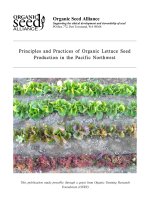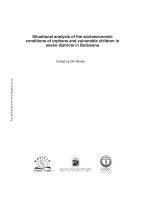explanation and examination of hit and run play in baseball
Bạn đang xem bản rút gọn của tài liệu. Xem và tải ngay bản đầy đủ của tài liệu tại đây (28.62 KB, 2 trang )
Baseball is a game of individuals and confrontations between
individuals. At that moment when the pitcher stares into the catcher's mitt,
scratches himself, gets into his windup, and fires the pitch home, it's all
between him and the batter. There may fielders in set and ready position
on the field, baserunners languishing off their bases, and teammates and
coaches watching anxiously from the dugout, but during those few
nanoseconds of drama, baseball becomes a two player game. Likewise,
on virtuallany play - a flyball, a grounder, a popup etc. - all attention
focuses only on the fielder and perhaps the runner that he will attempt to
throw out. All plays that is, except for the hit-and-run. Simply put, a hit
and run is a play in which a runner on any base (usually first) takes off as
soon as the pitcher releases the ball, and the batter at the plate attempts
to make contact no matter what kind of pitch he gets and wherever it's
thrown. Wi the exception of a double steal, the hit and run is the only play
in which two players on the offensive team work in conjunction with one
another. The coach or manager who makes the call must take care to
select an instance in which the runner can get decent jump and the
pitcher throws a good pitch to hit. The batter must make every attempt to
put the ball in play, or if he cannot, do anything he can to "protect the
runner"; meaning he must time and place his swing accurately enough to
block the catcr's ability to see the fielder covering second and throw
accurately. Obviously, the hitter and runner both have to be aware that
they will be attempting to execute a hit and run and the pitcher has to be
careful to both hold the runner and throw a good tch, making a
hit-and-run one of the few instances in which the action and confrontation
expand past the usual one-on-one format. As with all risky actions in
life, the hit-and-run can yield great dividends or cause great losses for the
team attempting to execute it. The advantages of a successful hit and run
include allowing the baserunner to take an extra base on a base hit or
eak up a double play on a groundball. The disadvantages include
minimizing the effectiveness of a good hitter (since he's forced to swing,
no matter what comes at him), or worse, causing a
strike-em-out-throw-em-out double play if the batter is unsuccesul at
making contact. That can totally destroy a potentially big inning. As a
result, the-hit-and-run is generally executed only when there's a good
runner on base and an above average hitter at the plate. One would not,
for example, expect to see Luis jo executing the "hit" part of a hit-and-run
with Cecil Fielder on the basepaths. As a matter of fact, you wouldn't
likely see the free-swinging and oft-missing Fielder involved in a
hit-and-run play from either vantage point. But, to use another
examplfrom the 1996 World Champions, two current Yankees who might
have a higher likelihood of implementing a successful hit-and-run
together are Wade Boggs, who despite being 169 years old remains one
of the purest hitters in the game and can consistently beelied upon to put
the ball in play, and Bernie Williams, one of the fastest runners on the
team. Their combined contact ability and swiftness make them perhaps
the quintessential example of a model hit-and-run duo. It should be
noted however, that speed is not the only skill required for the player
attempting the tail end of the hit-and-run to be successful. Since the
runner is flying down the basepaths at full speed with all of his adrenaline
flowing, he must beble to make a lightning quick shift of gears and go
back to his original base, against his momentum, if the situation should
call for it (i.e. linedrive or popup). Therefore, in addition to speed, he must
also be a smart baserunner, able to make instanneous decisions and act
on them rapidly. That decision alone, whether to take another base, stand
at the current one, or backtrack to the previous one, can in some cases
be the deciding factor in determining the outcome of a play, an inning, or
an entirgame. And that is what makes Williams, with his five years of
big-league experience, a better hit-and-runner (with emphasis on the
"runner") than rookies Derek Jeter and Andy Fox, who may have more
speed, but lack baserunning smarts. A manager must consider a
myriad of other factors besides the hitter and runner(s) involved when
determining whether or not to call for a hit-and-run. "Who do I have due
up next? What hitters do I have on the bench? How good is the
opposition's pitcherand of what quality are the arms available in their
bullpen? What's the score? How many outs are there? How late in the
game is it? What is the morale of my team/ability to come back from
behind?" A good manager will consider all of these questions and re
before deciding to call for a hit-and-run If he sees that he has a bunch of
solid contact hitters due up, he may not want to increase the chance of an
out by calling for a hit and run. On the other hand, with two outs and the
bottom of the order cong up, he may want to call for the risky play even
with a runner of only average speed on the base paths. A tie or one run
game in the late innings may prompt a manager to risk going for the extra
base as well. So clearly, the hit-and-run is not a play at should be called
for haphazardly without considering all seemingly extraneous factors,
which in reality are crucial and fundamental in determining the sensibility
of calling for a hit-and-run. Knowing how to understand and take
advantage of them to t utmost, vis-à-vis the hit and run and other
strategies, separates a Joe Torre, a World Series championship manager
who is confident in his ability to gauge potential hit-and-run situations and
capitalize on them, from a Buck Showalter, a much more consvative
manager, who, perhaps because he didn't know how and when to use the
hit-and-run effectively, rarely called for it, and eventually lost his job.
All in all, the excitement of a hit-and-run is pretty much
unparalleled in baseball. For those who complain that it's a boring sport,
the hit-and-run provides running, hitting, pitching, defensive maneuvering,
and throwing all on one play. It can also as climacteric as it is dramatic;
successful or unsuccessful implementation of the hit-and-run can often
be the difference between triumphant victory or crushing defeat. It may
well be the most strategy oriented, thought provoking element of the
game. e hit-and-run expands baseball beyond the one-on-one
confrontations that some people may perhaps find unappealing about the
game, and keeps everyone on his toes.









